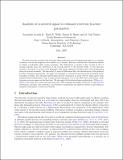Analysis of Scattered Signal to Estimate Reservoir Fracture Parameters
Author(s)
Grandi, Samantha K.; Willis, Mark E.; Burns, Daniel R.; oksoz, M. Nafi
DownloadGrandi_ERL2007.pdf (640.6Kb)
Other Contributors
Massachusetts Institute of Technology. Earth Resources Laboratory
Metadata
Show full item recordAbstract
We detect fracture corridors and determine their orientation and average spacing based on an analysis of seismic coda in the frequency-wave number (f-k ) domain. Fracture corridors have dimensions similar to seismic wavelengths which causes scattering. The distribution of energy in shot records in the f-k domain depends upon the orientation of the records relative to the fracture strike. In the direction normal to fractures, scattered waves propagate with slower apparent velocities than waves propagating along the fracture channels. The associated f-k spectral differences allow the identification of the preferred fracture orientation and spacing. We apply our technique to a fractured reservoir in the Lynx field, in the Canadian foothills. The estimated preferential fracture orientation is about N40 E, which agrees with regional stress measurements. The average fracture spacing is 75 m on the West side of the survey, while fractures are more sparse on the East side. We also apply the Scattering Index methodology (Willis et al., 2006) to the same data, post-stack and pre-stack. This technique has higher resolution to map fracture distribution, intensity and orientation, and therefore complements the spectral method in providing an integrated description of reservoir fractures.
Date issued
2007-05Publisher
Massachusetts Institute of Technology. Earth Resources Laboratory
Series/Report no.
Earth Resources Laboratory Industry Consortia Annual Report;2007-04